Unsupervised Deep Learning for Advanced Forming Limit Analysis in Sheet Metal: A Tensile Test-Based Approach
Abstract
:1. Introduction
2. Materials and Experimental Setup
2.1. Materials
2.2. Experimental Setup
3. Method
3.1. Numerical Approach
3.1.1. Preprocessing
3.1.2. Training
3.1.3. Clustering and Postprocessing
3.1.4. Evaluation
3.2. Image-Based Approach
3.2.1. Preprocessing
3.2.2. Training
3.2.3. Postprocessing and Evaluation
4. Results
4.1. Numerical Approach
4.1.1. Prediction of Diffuse Necking
4.1.2. Prediction of Localized Necking
4.2. Image-Based Approach
5. Discussion
6. Summary
- Numerical approach was adapted from Jaremeenko, utilizing a Siamese network based on VGG16 architecture. This network was trained using a contrastive loss function to predict the time point of instability based on three channels: major strain, minor strain and material thickness, primarily for detecting diffuse necking.
- –
- Furthermore, the method’s functionality remains unaffected by the specific location of diffuse necking.
- –
- However, it’s important to note that this approach showed dependencies related to the division of the training data.
- Image-based approach, an innovative image-based approach for detecting localized necking was introduced. The architecture includes a Siamese network with DenseNet as a backbone trained through triplet loss. The network used as an input the images captured by a stereo camera system.
- –
- This approach replaces the need for labor-intensive strain calculations using Digital Image Correlation (DIC) with input from a stereo camera system. This shift greatly streamlines computational efficiency and reduces the effort needed to establish the support point on the forming limit curve.
- –
- The method demonstrates insensitivity to the formation of multiple strain maxima during the forming process. While the repeatability of this method is slightly lower than the standard method, it can be improved in future studies by diversifying the dataset.
- –
- In addition, the functionality of the method is independent of the location where the localized necking occurs.
- –
- For materials such as DX54D and AA6016, our method successfully predicted major strains in close agreement with ISO standards. However, it did not yield satisfactory results for DP800.
- –
- The repeatability of the method is less than the standard method, but can be improved for future studies by increasing the variance in the data set.
Author Contributions
Funding
Data Availability Statement
Conflicts of Interest
References
- Cao, J.; Banu, M. Opportunities and Challenges in Metal Forming for Lightweighting: Review and Future Work. J. Manuf. Sci. Eng. 2020, 142, 110813. [Google Scholar] [CrossRef]
- Keeler, S.; Backhofen, W. Plastic instability and fracture in sheets stretched over rigid punches. ASM Trans. Q. 1963, 56, 25–48. [Google Scholar]
- Goodwin, G.M. Application of Strain Analysis to Sheet Metal Forming Problems in the Press Shop. SAE Trans. 1968, 77, 380–387. [Google Scholar]
- ISO 12004-2:2008; Metallic Materials-Sheet and Strip-Determination of Forming-Limit Curves-Part 2: Determination of Forming-Limit Curves in the Laboratory. ISO: Geneva, Switzerland, 2008.
- Nakajima, K.; Kikuma, T.; Hasuka, K. Study on the Formability of Steel Sheets; Yamata Technical Report, No. 264; Technical Research Institute, Yawata Works, 1968; pp. 8517–8530. [Google Scholar]
- Marciniak, Z. Stability of plastic shells under tension with kinematic boundary conditions(Stability of plastic shell under tension). Arch. Mech. Stosow. 1965, 17, 577–592. [Google Scholar]
- Kohl, D.; Merklein, M. Determination of Forming Limit Curves-Strain Path and Failure Analysis. Key Eng. Mater. 2022, 926, 947–954. [Google Scholar] [CrossRef]
- Derogar, A.; Djavanroodi, F. Artificial Neural Network Modeling of Forming Limit Diagram. Mater. Manuf. Process. 2011, 26, 1415–1422. [Google Scholar] [CrossRef]
- Kotkunde, N.; Deole, A.D.; Gupta, A.K. Prediction of Forming Limit Diagram for Ti-6Al-4V Alloy Using Artificial Neural Network. Procedia Mater. Sci. 2014, 6, 341–346. [Google Scholar] [CrossRef]
- Elangovan, K.; Sathiya Narayanan, C.; Narayanasamy, R. Modelling of forming limit diagram of perforated commercial pure aluminium sheets using artificial neural network. Comput. Mater. Sci. 2010, 47, 1072–1078. [Google Scholar] [CrossRef]
- Di Lorenzo, R.; Ingarao, G.; Micari, F. An Intelligent Tool to Predict Fracture in Sheet Metal Forming Operations. Key Eng. Mater. 2007, 344, 841–846. [Google Scholar] [CrossRef]
- Greve, L.; Schneider, B.; Andres, M.; Martinez, J.; Eller, T.; vd Weg, B.; Hazrati, J.; vd Boogaard, A. Computationally efficient necking prediction using neural networks trained on virtual test data. In IOP Conference Series: Materials Science and Engineering. Proceedings of the 38th International Deep Drawing Research Group Annual Conference (IDDRG 2019), Enschede, The Netherlands, 3–7 June 2019; IOP Publishing: Bristol, UK, 2019; Volume 651, p. 012054. [Google Scholar]
- Bonatti, C.; Mohr, D. Neural network model predicting forming limits for Bi-linear strain paths. Int. J. Plast. 2021, 137, 102886. [Google Scholar] [CrossRef]
- Aleyasin, H. The prediction of Froming Limit Diagram of Low Carbon Steel Using Adaptive Fuzzy Inference System Identifier. J. Solid Mech. 2017, 09, 472–489. [Google Scholar]
- Zhang, M.; Meng, Z.; Shariati, M. ANFIS-based forming limit prediction of stainless steel 316 sheet metals. Sci. Rep. 2023, 13, 3115. [Google Scholar] [CrossRef] [PubMed]
- Jaremenko, C.; Affronti, E.; Maier, A.; Merklein, M. Analysis of forming limits in sheet metal forming with pattern recognition methods. Part 2: Unsupervised methodology and application. Materials 2018, 11, 1892. [Google Scholar] [CrossRef] [PubMed]
- Jaremenko, C.; Ravikumar, N.; Affronti, E.; Merklein, M.; Maier, A. Determination of forming limits in sheet metal forming using deep learning. Materials 2019, 12, 1051. [Google Scholar] [CrossRef] [PubMed]
- Affronti, E.; Jaremenko, C.; Merklein, M.; Maier, A. Analysis of forming limits in sheet metal forming with pattern recognition methods. Part 1: Characterization of onset of necking and expert evaluation. Materials 2018, 11, 1495. [Google Scholar] [CrossRef] [PubMed]
- ISO 6892-1:2009; Metallische Werkstoffe-Zugversuch-Teil 1: Prüfverfahren bei Raumtemperatur. ISO: Berlin, Germany, 2009.
- Simonyan, K.; Zisserman, A. Very deep convolutional networks for large-scale image recognition. arXiv 2014, arXiv:1409.1556. [Google Scholar]
- Deng, J.; Dong, W.; Socher, R.; Li, L.-J.; Li, K.; L, F.-F. Imagenet: A large-scale hierarchical image database. In Proceedings of the 2009 IEEE Conference on Computer Vision and Pattern Recognition, Miami, FL, USA, 20–25 June 2009; pp. 248–255. [Google Scholar]
- Chopra, S.; Hadsell, R.; LeCun, Y. Learning a similarity metric discriminatively, with application to face verification. In Proceedings of the 2005 IEEE Computer Society Conference on Computer Vision and Pattern Recognition (CVPR’05), San Diego, CA, USA, 20–25 June 2005; Volume 1, pp. 539–546. [Google Scholar]
- Goodfellow, I.; Bengio, Y.; Courville, A. Deep Learning; MIT Press: Cambridge, MA, USA, 2016. [Google Scholar]
- Hadsell, R.; Chopra, S.; LeCun, Y. Dimensionality reduction by learning an invariant mapping. In Proceedings of the 2006 IEEE Computer Society Conference on Computer Vision and Pattern Recognition (CVPR’06), New York, NY, USA, 17–22 June 2006; Volume 2, pp. 1735–1742. [Google Scholar]
- Abdi, H.; Williams, L.J. Principal component analysis. Wiley Interdiscip. Rev. Comput. Stat. 2010, 2, 433–459. [Google Scholar] [CrossRef]
- Peel, D.; McLachlan, G.J. Robust mixture modelling using the t distribution. Stat. Comput. 2000, 10, 339–348. [Google Scholar] [CrossRef]
- Huang, G.; Liu, Z.; Van Der Maaten, L.; Weinberger, K.Q. Densely connected convolutional networks. In Proceedings of the IEEE Conference on Computer Vision and Pattern Recognition, Honolulu, HI, USA, 21–26 July 2017; pp. 4700–4708. [Google Scholar]
- Hoffer, E.; Ailon, N. Deep metric learning using triplet network. In Proceedings of the Similarity-Based Pattern Recognition: Third International Workshop, SIMBAD 2015, Copenhagen, Denmark, 12–14 October 2015; pp. 84–92. [Google Scholar]
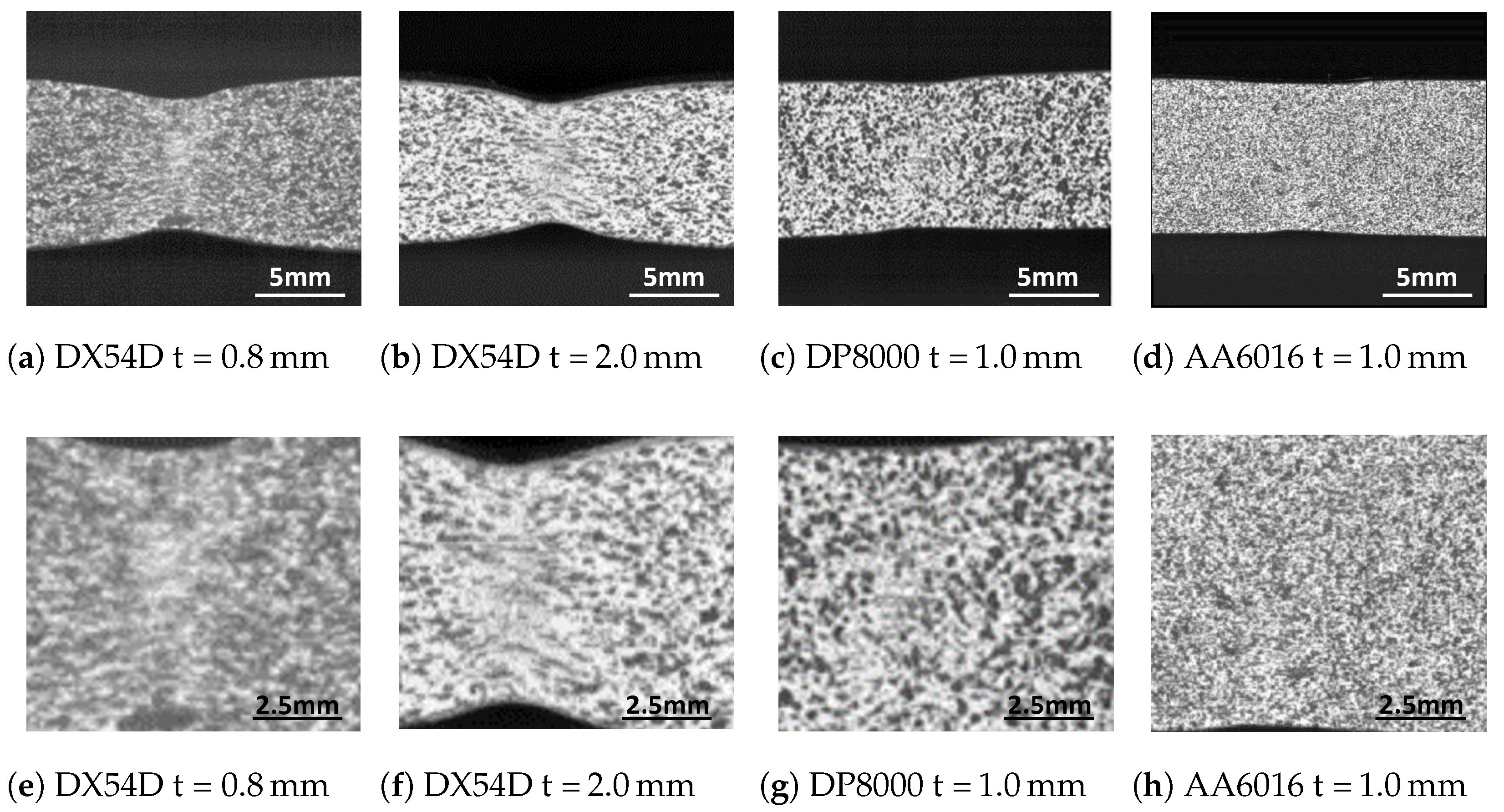
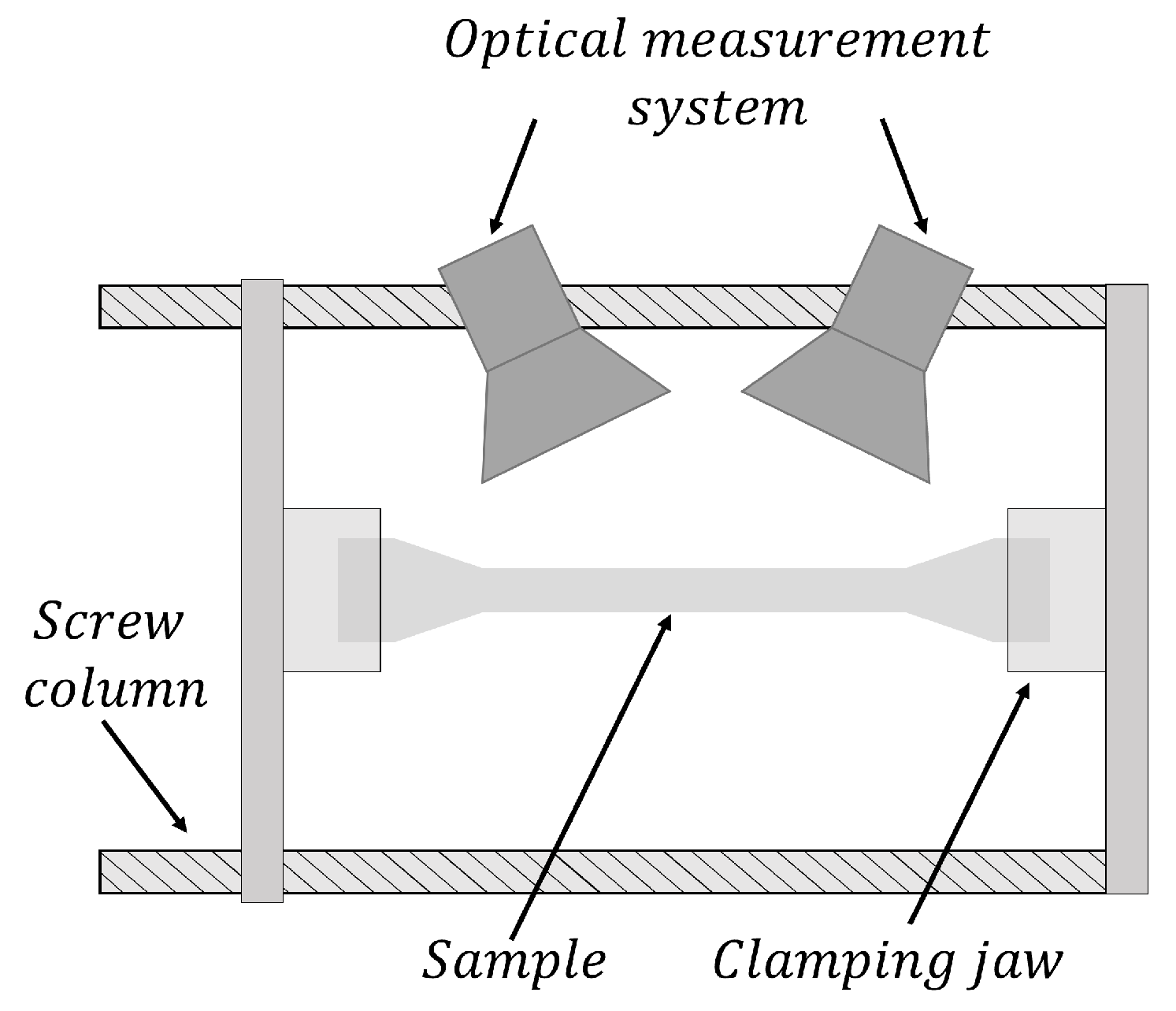


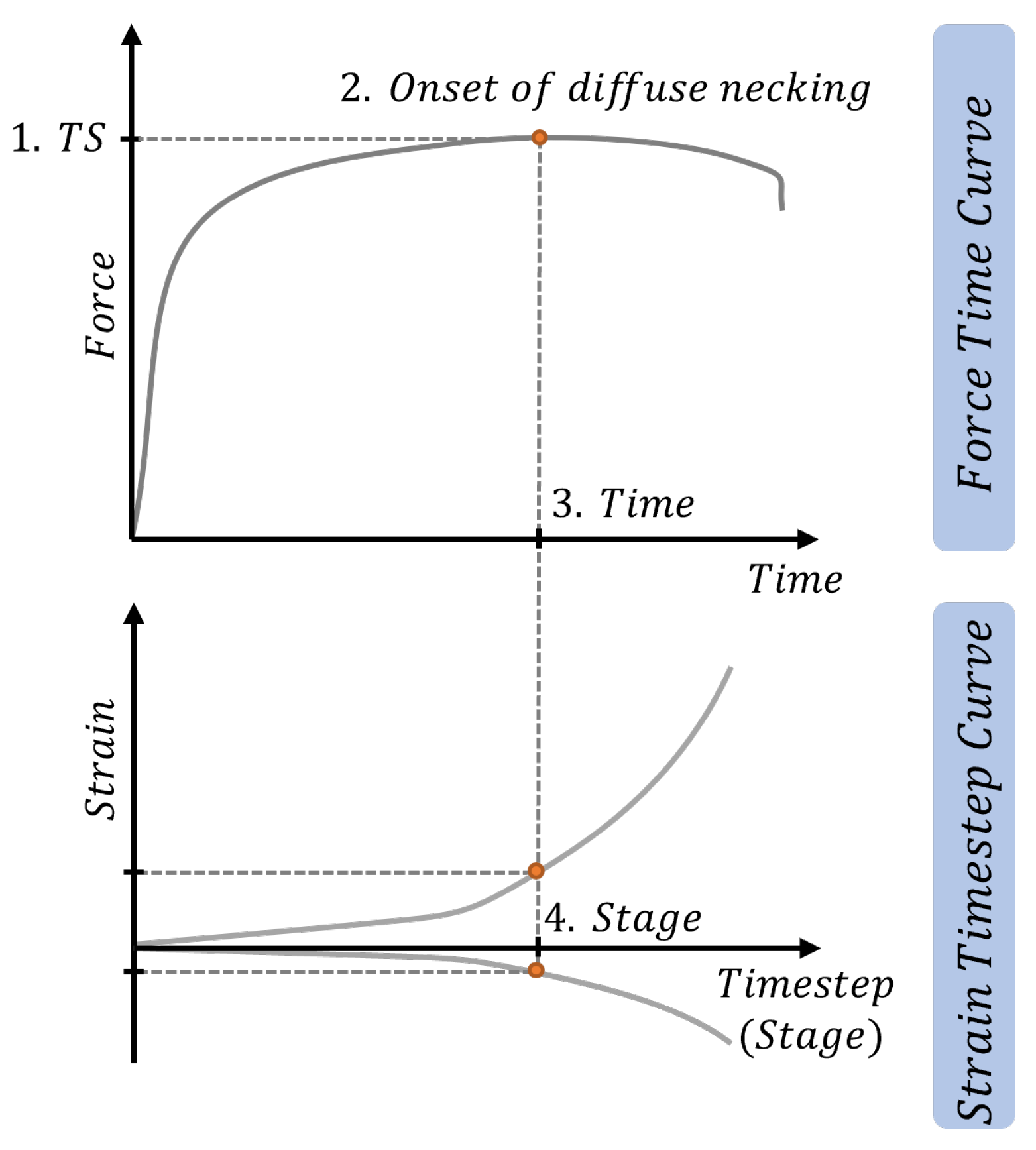
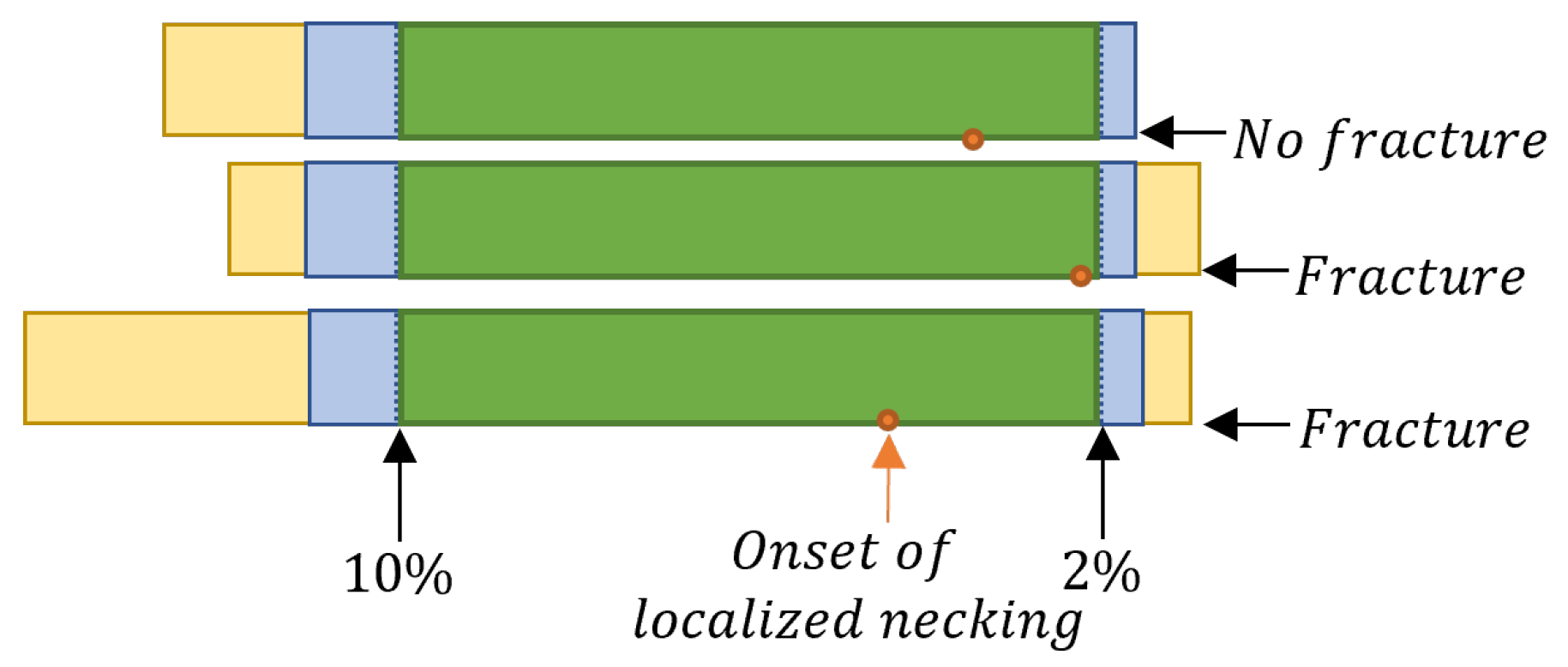
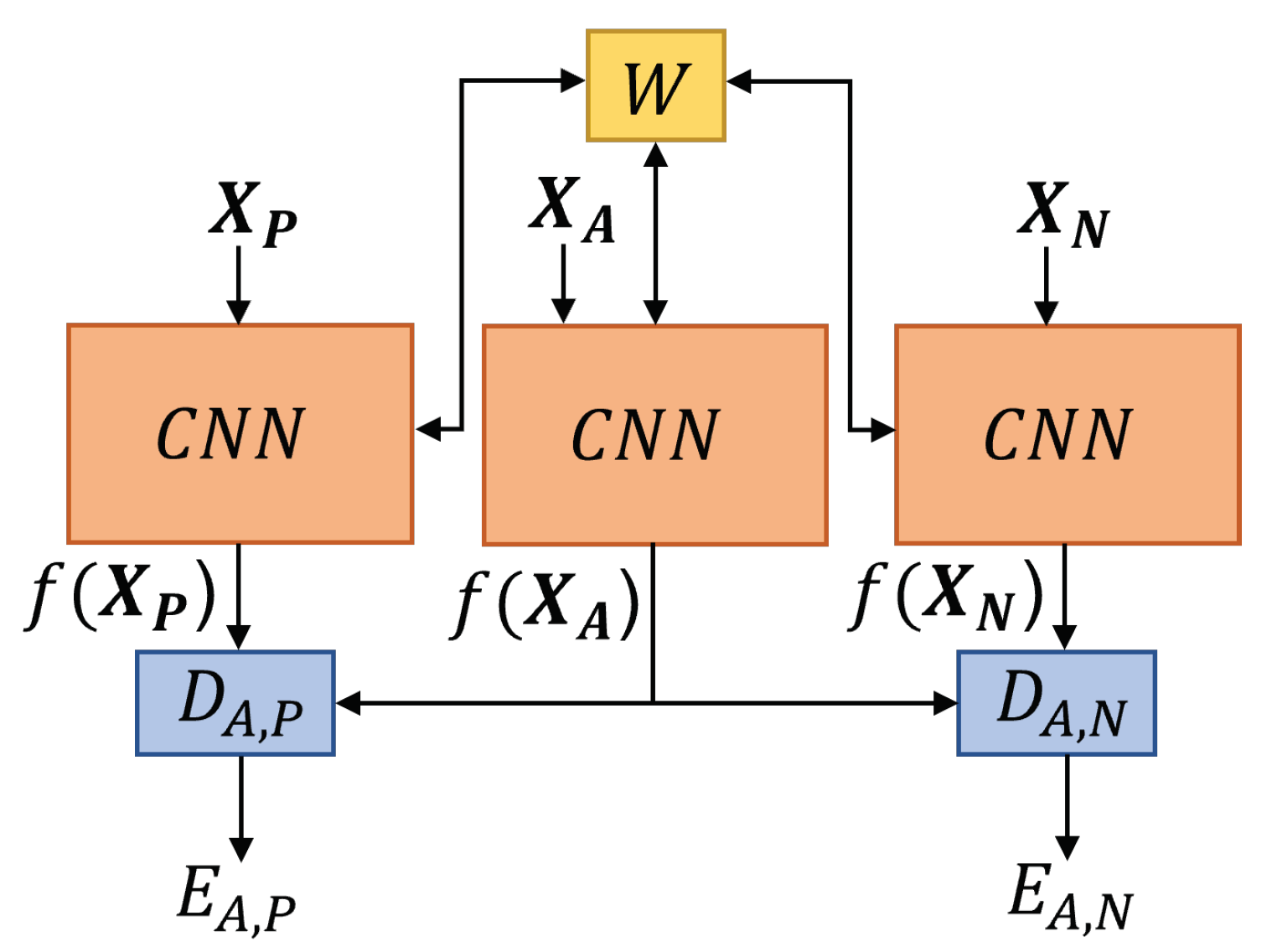

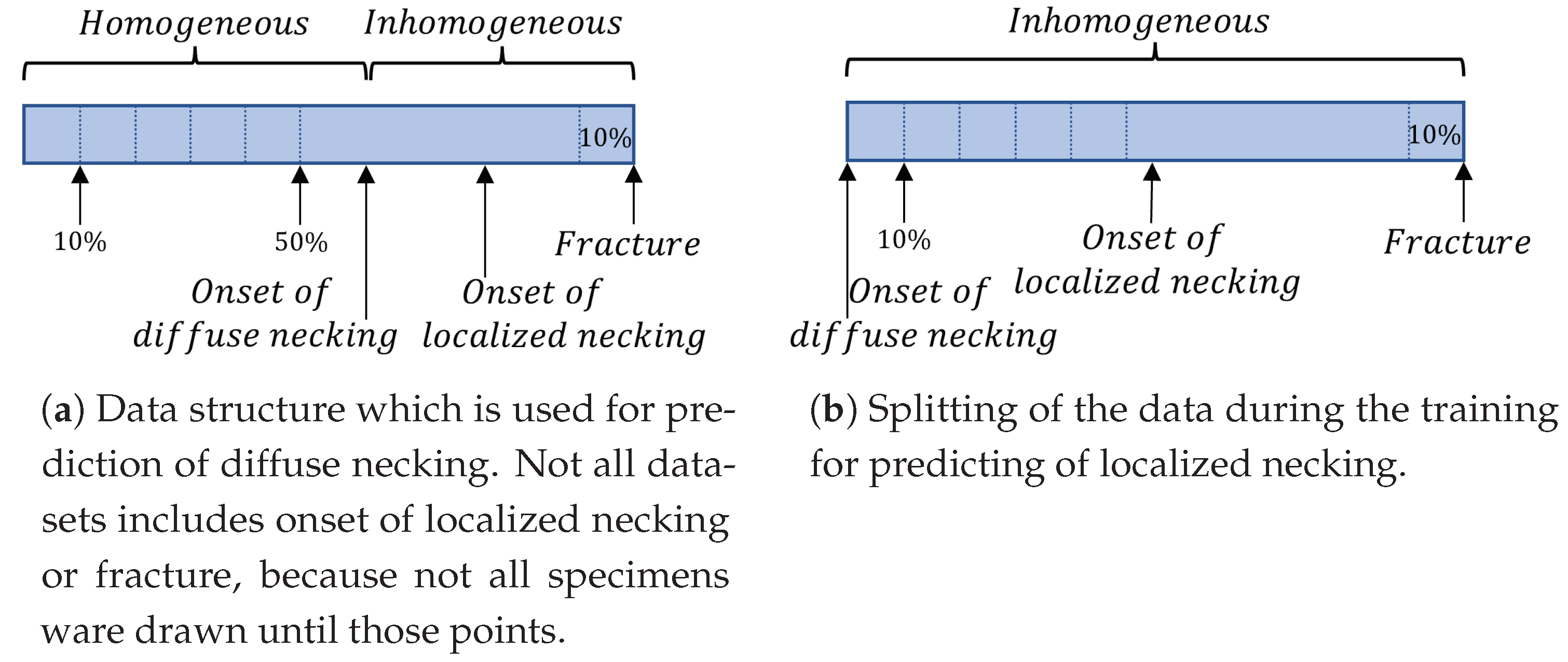
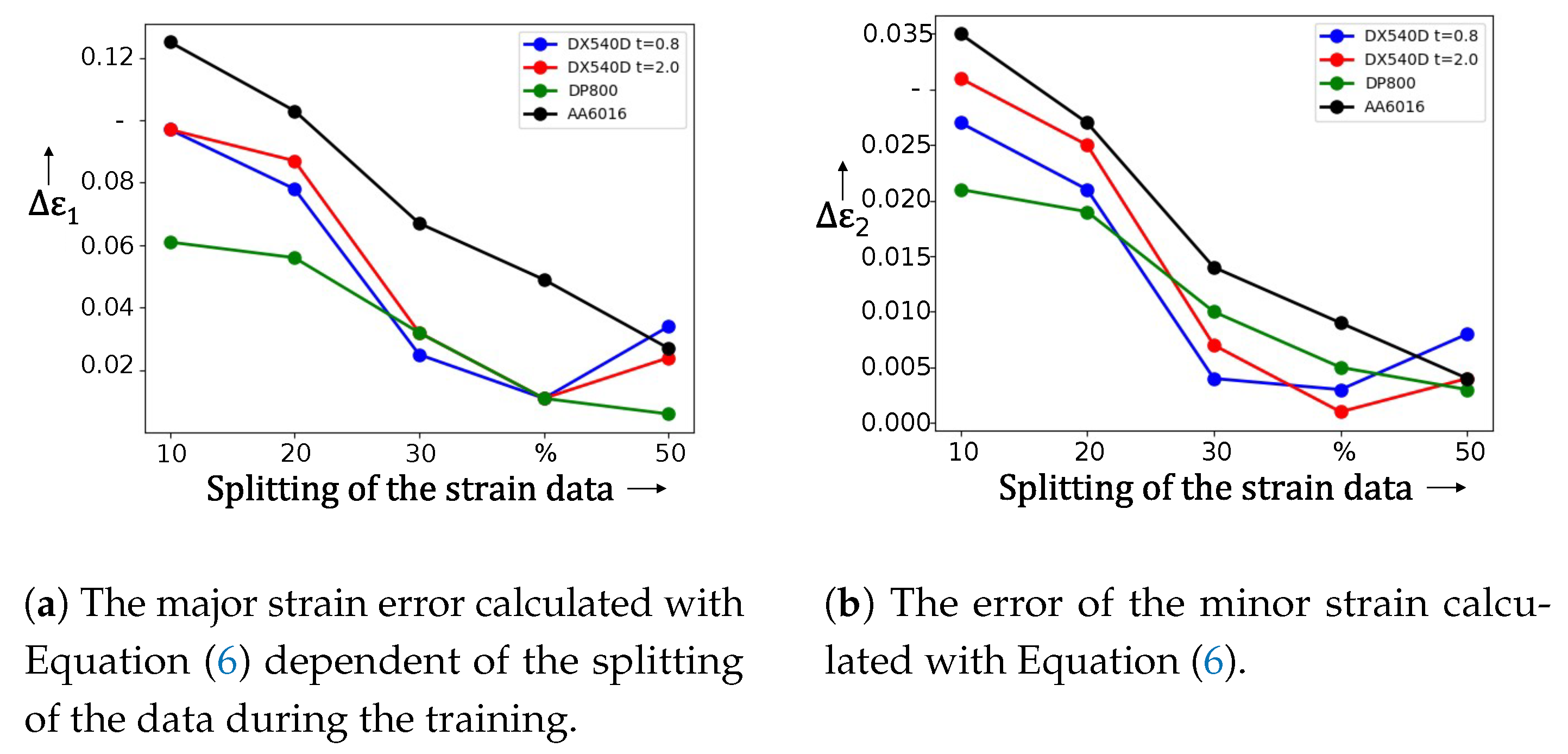
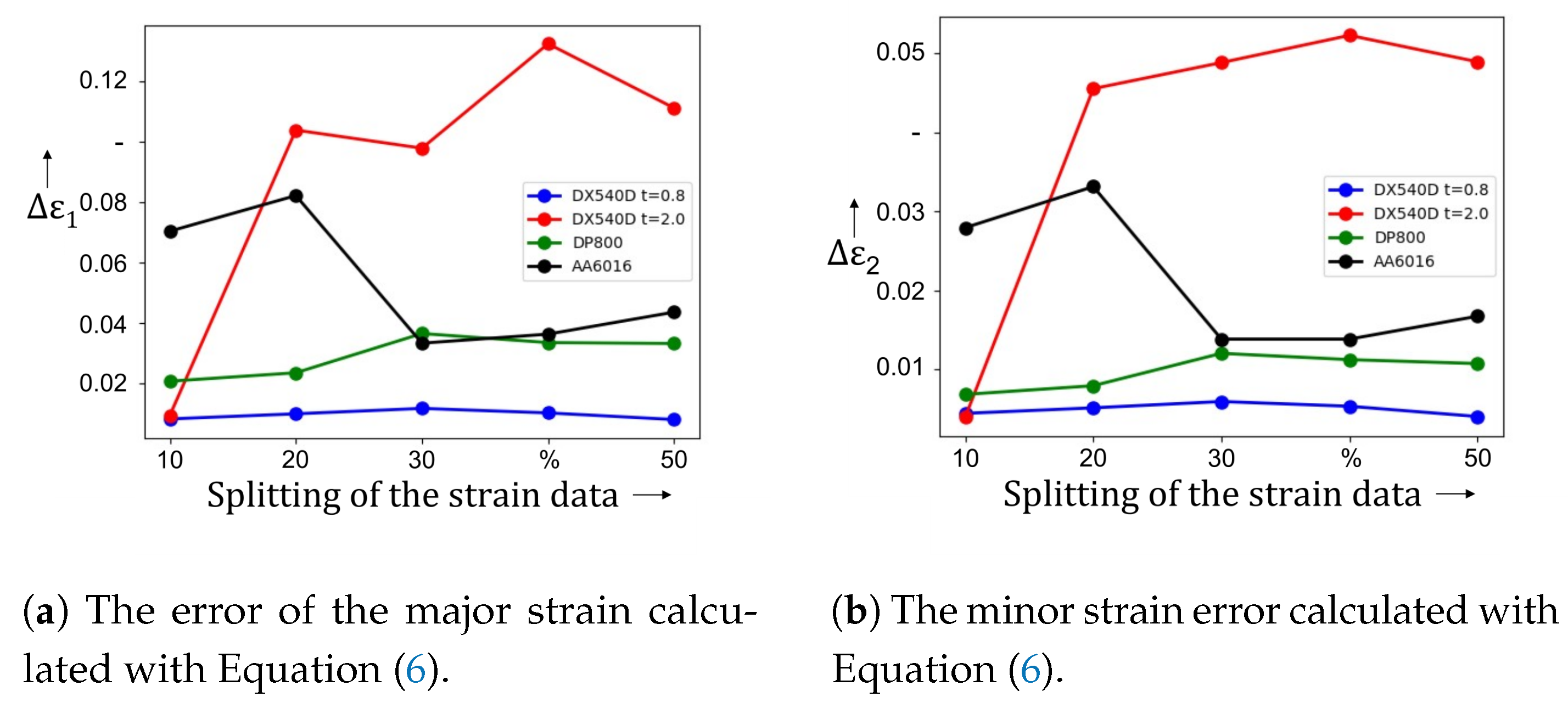



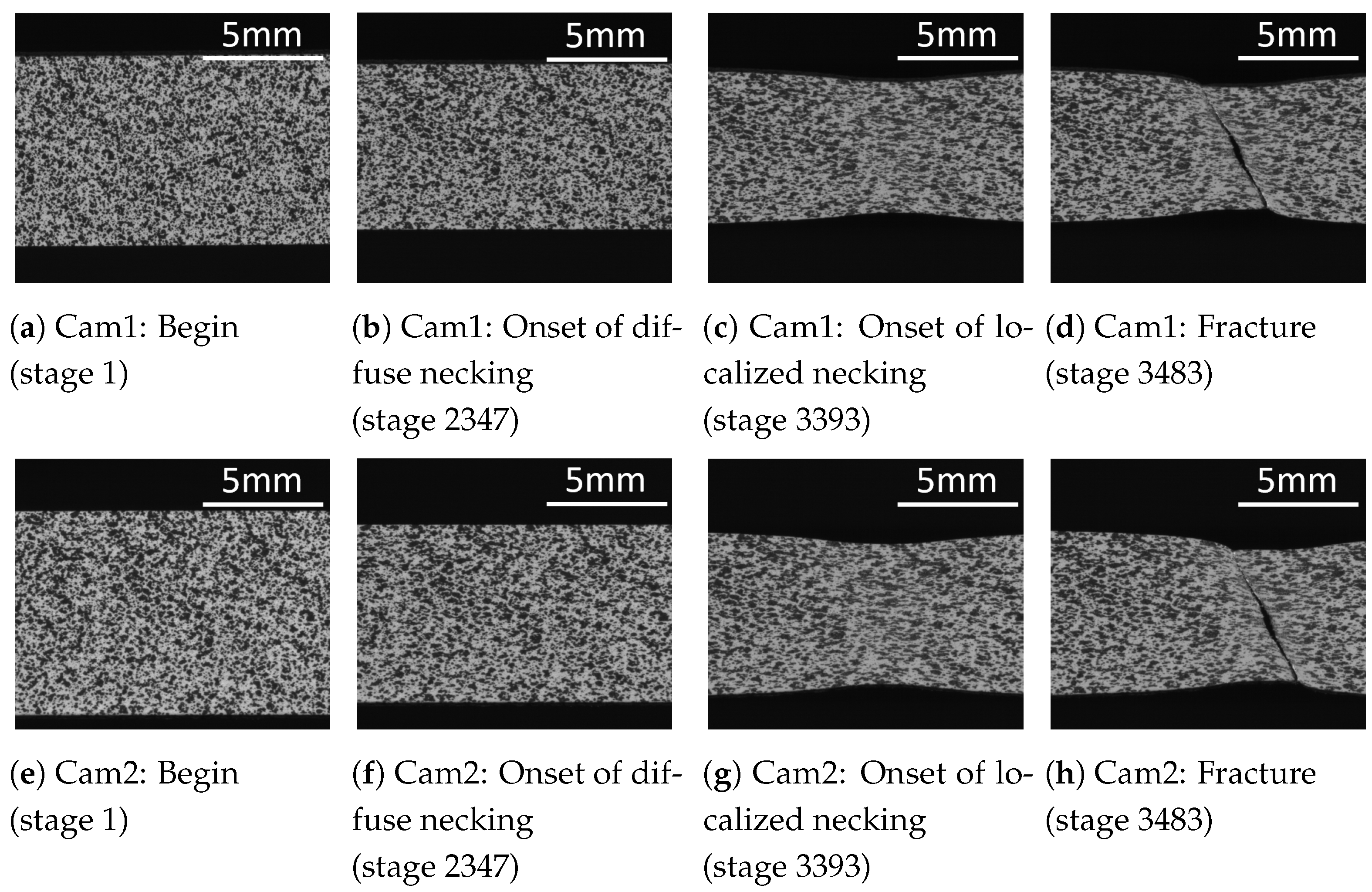
| Material | in mm | (MPa) | (MPa) | (%) |
|---|---|---|---|---|
| DX54D | 0.8 | 173.8 | 316.6 | 22 |
| DX54D | 2.0 | 170.1 | 303.1 | 22 |
| DP800 | 1.0 | 580.2 | 872.4 | 11 |
| AA6016 | 1.0 | 154.4 | 261.1 | 17 |
| Material | C | Si | Mn | P | S | Ti | Al | Cr + Mo | Mg | Ni | Zn | Cu |
|---|---|---|---|---|---|---|---|---|---|---|---|---|
| DX54D | 0.12 | 0.5 | 0.6 | 0.1 | 0.045 | 0.3 | - | - | - | - | - | - |
| DP800 | 0.15 | 0.42 | 2.06 | 0.008 | 0.002 | - | 0.57 | 0.408 | - | - | - | - |
| AA6016 | - | 0.5 | 0.25–0.6 | - | - | - | - | - | 0.1 | 0 | 0.15 | 0.2 |
| Material | n | ||
|---|---|---|---|
| DX54D ( mm) | 36 | 7 | 4 |
| DX54D ( mm) | 39 | 7 | 7 |
| DP800 | 38 | 8 | 6 |
| AA6016 | 39 | 7 | 7 |
| Material and | Measured | Predicted | ||||||
|---|---|---|---|---|---|---|---|---|
| DX54D (0.8 mm) | 315 | 21 | 0.234 | −0.137 | 315 | 21 | 0.222 | −0.131 |
| DX54D (2.0 mm) | 299 | 22 | 0.237 | −0.139 | 296 | 28 | 0.336 | −0.183 |
| DP800 (1.0 mm) | 887 | 11 | 0.116 | −0.039 | 884 | 12 | 0.149 | −0.051 |
| AA6016 (1.0 mm) | 256 | 17 | 0.192 | −0.077 | 255 | 12 | 0.158 | −0.064 |
| Material and | Prediction | ISO 12004 | ||
|---|---|---|---|---|
| DX54D (0.8 mm) | ||||
| DX54D (2.0 mm) | ||||
| DP800 (1.0 mm) | ||||
| AA6016 (1.0 mm) | ||||
Disclaimer/Publisher’s Note: The statements, opinions and data contained in all publications are solely those of the individual author(s) and contributor(s) and not of MDPI and/or the editor(s). MDPI and/or the editor(s) disclaim responsibility for any injury to people or property resulting from any ideas, methods, instructions or products referred to in the content. |
© 2023 by the authors. Licensee MDPI, Basel, Switzerland. This article is an open access article distributed under the terms and conditions of the Creative Commons Attribution (CC BY) license (https://creativecommons.org/licenses/by/4.0/).
Share and Cite
Thamm, A.; Thamm, F.; Sawodny, A.; Zeitler, S.; Merklein, M.; Maier, A. Unsupervised Deep Learning for Advanced Forming Limit Analysis in Sheet Metal: A Tensile Test-Based Approach. Materials 2023, 16, 7001. https://doi.org/10.3390/ma16217001
Thamm A, Thamm F, Sawodny A, Zeitler S, Merklein M, Maier A. Unsupervised Deep Learning for Advanced Forming Limit Analysis in Sheet Metal: A Tensile Test-Based Approach. Materials. 2023; 16(21):7001. https://doi.org/10.3390/ma16217001
Chicago/Turabian StyleThamm, Aleksandra, Florian Thamm, Annette Sawodny, Sally Zeitler, Marion Merklein, and Andreas Maier. 2023. "Unsupervised Deep Learning for Advanced Forming Limit Analysis in Sheet Metal: A Tensile Test-Based Approach" Materials 16, no. 21: 7001. https://doi.org/10.3390/ma16217001
APA StyleThamm, A., Thamm, F., Sawodny, A., Zeitler, S., Merklein, M., & Maier, A. (2023). Unsupervised Deep Learning for Advanced Forming Limit Analysis in Sheet Metal: A Tensile Test-Based Approach. Materials, 16(21), 7001. https://doi.org/10.3390/ma16217001







